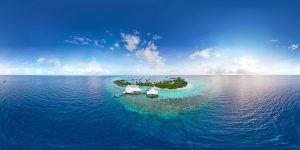A startling new discovery has challenged the longstanding view that the Indian Ocean archipelago of the Maldives is doomed by melting ice caps to disappear beneath the surging tides.
Defying the dire predictions, some low-lying islands have instead grown despite the sea level rising by about an inch each decade, scientists found in a study that compared aerial photos from the mid-20th century to recent satellite images. As the ocean surged, these buoyant islands appear to have expanded in tandem.
Other islands shrank as global warming accelerated erosion and stronger waves gradually gobbled up the beach. But most islands remained stable in size, researchers found.
Scientists are trying to understand how waves could both destroy and enlarge coastlines, eroding beaches on one side and piling up sand and sediment on the other.
“All the evidence to date is that the islands are changing and dynamic. There are very few examples of islands disappearing. Much of the evidence, not just in the Maldives but in the Pacific, is that islands are changing, are mobile,” Paul Kench, professor of tropical coastal change at the National University of Singapore, told The Times newspaper from the United Kingdom.
Kench was the co-author of a 2010 study of 27 Pacific islands that complicated the picture of rising seas eventually submerging small island states. The shape of some islands had shifted with erosion and expansion on the edges but their total land area remained largely unchanged, the study found.
This confounding pattern of shrinking, growing, and stable islands has since been identified in nearly 1,000 tropical islands studied in recent years, the New York Times reported in late June. The pattern was consistent across several of the 1,192 islands of the Maldives, most of which stand just one meter above sea level.
In the southern Maldives atoll of Huvadhoo, for instance – the largest natural atoll in the world, with 241 islands – 42 percent lost ground to erosion, 39 percent remained stable, and 20 percent grew in size, researchers found. Intriguingly, the rate of erosion was not worse for islands in regions experiencing the fastest sea level rise.
Kench was back in the Maldives earlier this year with a team of scientists hoping to learn why some islands shrank while others grew. The group spent weeks measuring currents, mapping waves, and collecting sand samples. They hoped the wealth of data could be used to project how islands could change in the future.
The new research echoed previous findings about the natural defenses of islands. Coral reef ecosystems – the bedrock of the Maldivian islands formed over millennia atop the flanks of sunken volcanos – offer invaluable protection from flooding and swells. But hard engineering solutions to beach erosion such as sea walls, breakwaters, and land reclamation undermine this natural coastal protection.
The environmental side effects of infrastructure projects were pushing the majority of inhabited islands to a threshold beyond which they cannot naturally adapt to climate risks, according to research published in the science journal Nature in late 2019. Based on the findings, researchers advised the authorities to preserve the defenses of unspoiled islands that still possessed the natural capacity to adjust.
The conclusions from the new research reflected the old advice.
“They’ve got a bit of time, but they need to be thinking about it quickly,” Kench told The New York Times. “To me, that’s the challenge: How do you coexist with the change that’s coming?”
The Maldives should accept the inevitability of losing shrinking islands and learn to live and work with nature, he suggested.
“There could be nature-based solutions such as looking at coastal protection measures, where the reef flat is nourished with dredged sand to supplement natural processes that wash it onto the island,” said Dr. Tim Scott, associate professor in ocean exploration at the University of Plymouth, who was part of the team that conducted research in the Maldives.
But inaction and resignation were both unacceptable to the Maldives Environment Minister Thoriq Ibrahim, whose administration favors the creation of elevated manmade islands as a climate change adaptation strategy. “If there’s coastal erosion, then we have to do something about it,” the minister told the New York Times. “We can’t just leave it, thinking that nature will expand the island.”

































